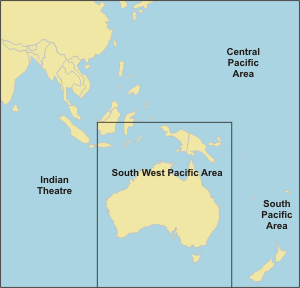In 1943 the issue of conscription arose.
As in 1916 and 1917, the government had the power to conscript men for home service, but not for overseas combat. 'Home', however, included New Guinea, where Australia had a protectorate, and therefore conscripted troops could be and were sent to the war front where they were needed most.

Cabinet approved the Defence (Citizen Military Forces) Act 1943, which provided for the use of Australian conscripts in the South West Pacific Area during the period of war. The Act also provided that this approval would lapse within six months of Australia’s ceasing to be involved in hostilities.
But as the Allies began to defeat the Japanese, the war front spread north, and there was a demand that Australian troops be able to go to the new areas which were outside the definition of 'home'. American conscripts were fighting in these areas so it seemed unfair that Australian conscripts should not also be compelled to fight there.
As in 1916 and 1917, all the government had to do was to change the Defence Act and it could achieve this; and, unlike the situation in 1916, Prime Minister Curtin knew he had the majority in both Houses to make this change.
He did not, however, push the measure through. Rather, he let the Australian Labor Party debate the issue, and come to their own decision which was to support the extension of areas where Australian conscripts could be sent to fight. This debate within the party allowed the opponents to be heard, but also showed how small a minority they were. This avoided a potentially ugly and divisive public brawl on the issue.
The Act was changed, the area where conscripts could be sent was extended - though still strictly limited - and it was all done with little opposition in the community.
To investigate this aspect of the Home Front experience by using evidence from the time, see Home Fronts at War, Ryebuck Media for ANZAC Day Commemoration Committee of Queensland.
More about the book HOME FRONTS AT WAR





